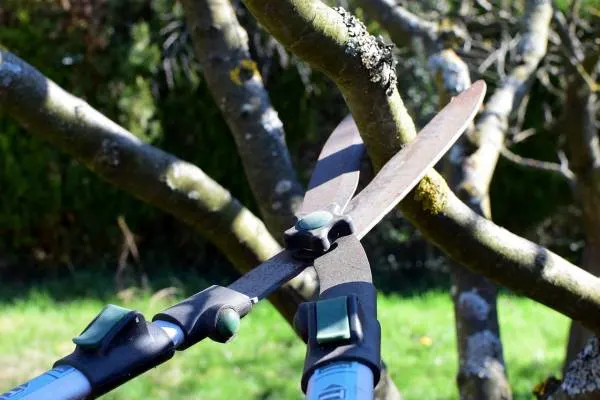From deciduous trees to evergreen perennials, nature has bestowed us with the grace of many beautiful plants that embellish our homes and gardens.
One of nature’s most flavorful and savory gifts is the orange tree!
Whether you want the aesthetic looks of lovely fruiting branches in your backyard or want to make an impregnable hedge around your property, these evergreen perennials prove to be an excellent addition to any landscape.
However, with great power comes great responsibility!
That is where pruning the orange trees comes in; having citrus trees in your garden will indeed make it a powerful center of attention, but you must know how to prune your orange trees to keep up their aesthetic appeal in the long run.
Orange tree pruning is essential for healthier plant growth and prolific harvest.
Furthermore, pruning orange trees controls their vigorous growth and maintains their shape by preventing rubbing and crisscrossing of the branches.
In today’s article, you’ll find everything you need to know about pruning your orange trees. From the best time of the year to the best techniques to prune orange trees, we’ve got you all covered.
So, with that said, let’s dive straight into it.
Pruning an Orange Tree | A Bird’s Eye View!
So far, we’ve discussed that pruning orange trees is pretty essential.
However, according to the University of Arizona, the general rule for pruning citrus trees is DON’T, which is actually quite true because, for most of the evergreen fruit trees, you only need to prune dead, diseased, crossing, or wayward branches to ensure better fruit growth.
As Henri Matisse once said:
“Instinct must be thwarted just as one prunes the branches of a tree so that it will grow better.”
So, you must prune your citrus tree the right way!
Once you are well-versed with the best pruning techniques highlighted in this article, you’ll be able to enjoy its benefits, such as better tree shape control, better aeration, prevention of diseases, and improved fruit quality.
However, if you don’t want to get your hands dirty, seeking help from a professional tree trimming service is also an excellent choice!
Nevertheless, here are a few points to keep in mind when you prune an orange tree:
Pruning orange trees is often unnecessary, except for addressing specific issues such as damaged or diseased limbs.
Removing sprouts, also known as “water sprouts” or “suckers,” can enhance productivity by redirecting the plant’s energy towards producing more fruit and promoting new growth.
Enhancing light penetration and air circulation within the canopy by pruning wild and crisscrossed branches from the center reduces the risk of fungal diseases and improves yields.
To prevent soil-borne diseases, a practice known as “skirting” or “skirt pruning” involves removing branches that hang down to the ground.
Pruning also revitalizes mature trees by eliminating unproductive wood and encouraging fresh growth.
Reducing the tree’s height and spread through pruning not only makes it more manageable for homeowners but also simplifies the harvest process when it’s time to pick ripe oranges.
Lastly, pruning orange trees also contributes to their overall aesthetic appeal.
Now, you have a brief overview of the benefits of pruning orange trees.
However, before you gear yourself up, knowing the best time to prune an orange tree is essential.
When to Prune Orange Trees? | The Best Time of the Year!
Usually, orange trees are grown in warm climates, but they can also be nurtured in colder climates if you place them indoors or inside a greenhouse.
When you want to prune an orange tree, seasonal timings are crucial to keep in mind.
For instance, in warmer regions where the temperature stays between 55–85°F (13–29°C) all year round, you can prune your orange trees in the early spring between February and March; however, in colder areas, delay the pruning until late February or April when the risk of frost has passed.
The best time to prune an orange tree is before bud break in the early spring or just after the fruit set in the late winter.
This allows the tree to recover and thrive during the upcoming growing season while minimizing the risk of stress, disease, and reduced fruit production.
Pruning citrus trees from May through the middle of October is not generally recommended since exposed limbs and trunks can be damaged by intense sunlight, possibly leading to sunscald or an infestation of Hendersonula bark rot (sooty mold).
Do not prune your citrus tree in the summer, as you will expose the branches and the trunk to harsh sun, which may cause sunburn.
You can prune young trees any time of the year if there is no danger of frost.
Moreover, sprouts can be removed anytime except late in the growing season.
How to Prune an Orange Tree? | Top 3 Pruning Techniques!
Finally, the time has come for you to learn how to prune orange trees correctly.
To gear up, you’ll need:
Pruning Shears
Pruning Saw
Ratchet Lopper
Additionally, you’ll need safety goggles, and if you have sensitive skin, you might want to cover yourself with a long-sleeved shirt and gloves.
You can easily remove small sprouts by hand and larger ones by pruning shears. Depending upon their size, you can remove dead or decayed branches using hand pruners or a pruning saw. Lastly, you can cut the larger limbs at the base using a lopper or a pruning saw.
Remember not to cut into the branch collar; when pruning a branch, leave a couple of inches from the branch where it meets the main trunk to avoid damaging the bark.
Also, if you see dark wood after cutting a diseased branch, it means the disease is still there, and you need to remove more.
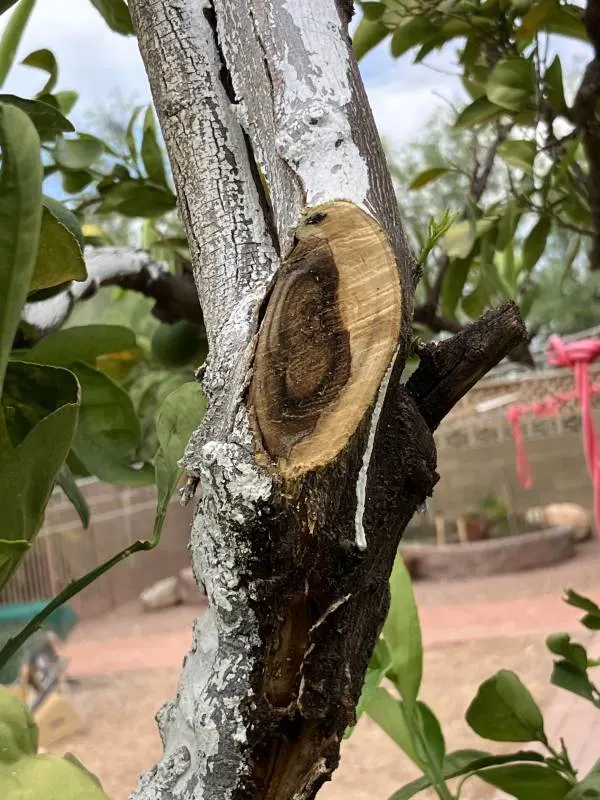
That’s all for the introduction!
Let’s move toward the guide to our first technique.
1. Yearly Pruning | A Step-by-Step Guide!
Yearly pruning is done to give your mature orange tree a boost.
After you prune an orange tree, it channels its energy into growing new thicker branches, resulting in a fruitful yield next year.
Following is a step-by-step guide for yearly pruning of your fruit tree.
Step 1: Disinfect Your Tools and Equipment
Before you begin, ensure you have all the tools and equipment ready and disinfected.
After removing any dirt and debris from your tools, sanitize them using a mixture of one part bleach and nine parts of water.
After disinfecting your gear, rinse it with clean water and pat it dry for proper use.
Use the disinfectant solution to clean your tools between cuts to prevent the spread of the disease.
Step 2: Choose the Right Time
Yearly pruning is best done during late winter to early spring, just before the tree starts its new growth cycle.
Avoid pruning during freezing temperatures or when the tree is in bloom, as it can stress the tree.
Step 3: Inspect the Tree’s Branches
Begin by closely inspecting the entire tree to identify branches that require pruning.
Look for:
Dead or diseased branches
Crossed branches that rub against each other
Water sprouts (vigorous vertical shoots)
Crowded areas
Let’s start cutting!

Step 4: Cut the Dead or Diseased Branches
Begin by cutting out any diseased or dead branches at their base.
Start with the lower branches and move your way up.
Make clean cuts outside the branch collar (the swollen area where the branch meets the trunk).
Step 5: Remove Crossed or Rubbing Branches
Identify branches that are crossing or rubbing against each other, as they can damage the bark and hinder growth.
Remove the weaker or less desirable ones to create space and prevent friction.
Pruning the tree’s canopy from the center will allow proper air circulation and more sunlight penetration toward the middle of the tree.
Step 6: Address Water Sprouts
Water sprouts are undesirable growths on fruit trees that often grow rapidly and don’t bear fruit.
They pop up from above or below the bud union and from large limbs or the base of the trunk and often out-compete the variety for the desired part of the canopy.
For these reasons, they should be removed.
Trim any water sprouts that are growing vigorously from the main branches. Cut them back to the branch they originate from or remove them entirely if they are overcrowding the tree.
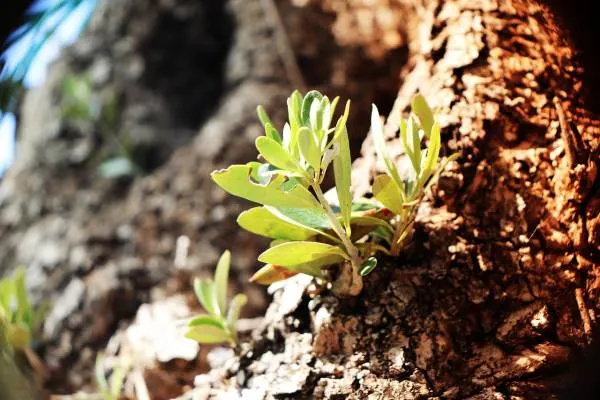
Step 7: Thin Out Crowded Areas
To improve aeration and light penetration, selectively thin out crowded areas. Trim branches too close together, allowing more space for healthy growth.
However, don’t go overboard with your annual pruning.
Trimming no more than one-third of the tree’s growth is recommended.
Step 8: Maintain the Desired Shape
While pruning, keep in mind the desired shape for your orange tree.
Whether you want an open canopy that allows sunlight to reach all parts of the tree or a bushier tree with hanging fruit branches, trim it accordingly to maintain the shape and balance you desire.

Step 9: Clean Up
Once you’ve finished pruning, clean up all debris and dispose of it properly.
Carefully manage the diseased parts of the tree to prevent the spread of the disease to other plants in the garden.
Lastly, clean and disinfect your pruning tools for future use.
2. Timely Pruning | Establishing an Orange Tree Sapling!
If you were able to stay with us till now, congratulations!
You are now well-equipped with the knowledge required for the annual pruning of orange trees.
However, now it’s time to discuss the best way to prune and establish a young tree sapling.
Start with a Balanced Foundation
When you first get your orange tree sapling, it’s like holding the beginnings of a beautiful story in your hands.
To ensure its success, begin with some initial pruning.
Take a deep breath, and don’t worry; it’s not as intimidating as it sounds.
You’ll want to trim the branches back by about 10 cm (4 inches) from their tips. This helps create a balance between the branches and the root system.
This initial pruning step is vital because it encourages your sapling to focus on building a solid core and promotes steady, healthy growth.
It’s like teaching your little orange tree to stand tall and proud.

Watch for Wayward Sprouts
In the first year of your sapling’s life, it’s a bit like looking after a mischievous toddler.
You’ll need to keep an eye out for sprouts or suckers that might pop up around the base of your tree. These little troublemakers can divert energy and nutrients away from the main tree, and we don’t want that!
So, don your gardening gloves, grab your pruners, and carefully remove these unwanted growths.
Say Goodbye to the Sick and Struggling
Just like you’d nurse a friend back to health, your orange tree sapling sometimes deserves treatment.
If you spot any dead, damaged, or diseased branches, it’s time for them to go.
Prune them off to prevent further trouble and help your tree put its energy into the healthy bits.
Banish Branches that Bump and Bruise
Imagine your sapling as a mini forest, with each branch jockeying for space.
Sometimes, they might grow unevenly or even bump into each other. Take a closer look and decide which branches are in the best position. These are the keepers, the ones with a bright future.
As for the branches that are constantly bumping into each other or just growing wonky, it’s time to say goodbye.
Make some strategic cuts to ensure harmony and balance in your mini forest.
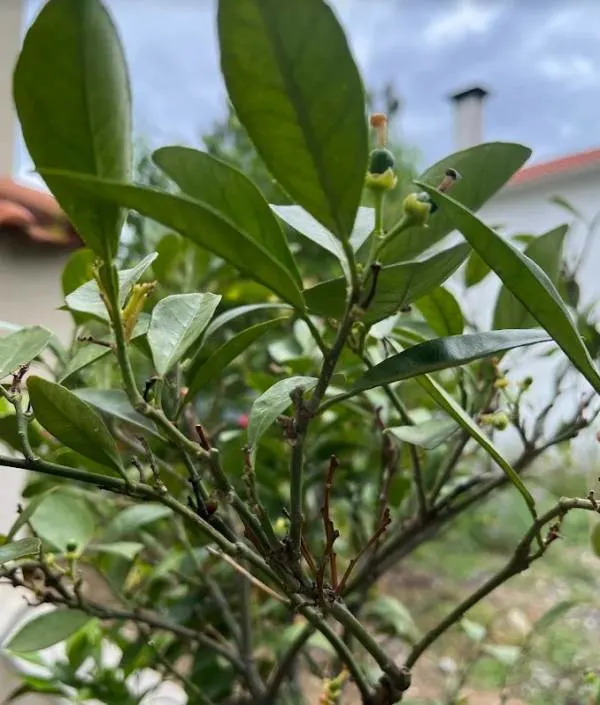
Thinning, Not Overdoing
When it comes to pruning your orange tree sapling, remember the golden rule: less is more.
The goal here is not to go overboard but to make only thinning cuts. Think of it as giving your sapling some breathing space, allowing sunlight to reach all the right places, and encouraging healthy growth.
So, there you have it—pruning your orange tree sapling is like guiding a young artist.
With care, patience, and the right snips here and there, you’ll set the stage for your tree’s future masterpiece of juicy oranges.
Now, let’s get to our final technique.
3. The Art of Heavy Pruning | Reviving Your Neglected Orange Tree!

It’s heartbreaking when you stumble upon a hidden treasure in your backyard, but it’s buried under overgrown branches and tangled twigs.
That’s what an orange tree can look like if neglected for too long.
Pruning older trees with heavy pruning is your secret weapon to breathe new life into your citrus trees.
Let’s dive into when and how to do it without even breaking a sweat.
When Does Heavy Pruning Become Essential?
If you’ve got an orange tree looking more like a wild jungle explorer than a well-behaved fruit producer, that’s your cue to consider heavy pruning.
Here’s when it becomes essential:
Neglected and Overgrown Trees: If your tree has been left to its own devices for years, growing taller and wilder, heavy pruning can help regain control.
Tall Trees that Aren’t Bearing Fruit: Imagine having a towering tree that’s all height and no fruit to show for it. If you haven’t been pruning much, it’s time for a vase cut (explained further in the article). Think of it as the ultimate makeover for your tree’s upper branches.
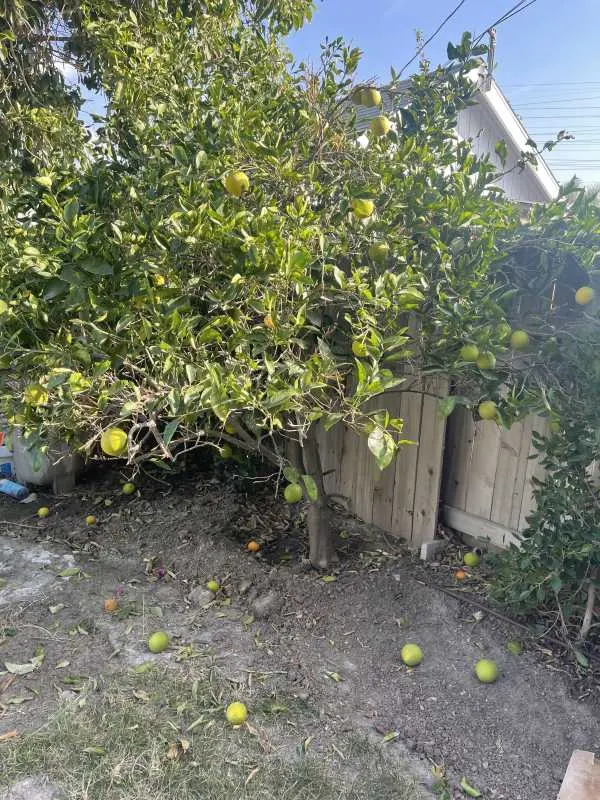
The Best Time to Get Heavy
Timing is everything, and it’s no different for heavy pruning. You want to ensure your orange tree is in the best possible mood for this makeover.
Here’s when to do it:
Dormant Season (Late Winter to Early Spring): This is the sweet spot. Prune your tree during its winter slumber, just before it wakes up with new buds and growth.
Frost-Free Days: Be mindful of the weather. You don’t want your tree to shiver in the cold after a heavy trim. So, wait until the frost is done for the season.
How to Get Heavy with the Pruning
Alright, you’ve decided it’s time for a major trim.
Here’s a simple guide to go about it without overwhelming your tree:
Remove Deadwood: Start by saying goodbye to dead or damaged branches. It’s like clearing out the clutter in your tree’s closet.
Gradual Trimming: Don’t rush! Heavy pruning is a gradual makeover, not an extreme one. Trim overgrown branches in stages, letting your tree adjust to each change.
Vase Cut for Tall Trees: Try a vase cut for those tall trees reaching for the sky but not giving you any oranges. Imagine shaping the top branches into a vase-like structure, allowing sunlight to reach the lower branches. It’s like creating a cozy spot for your tree to lounge in.
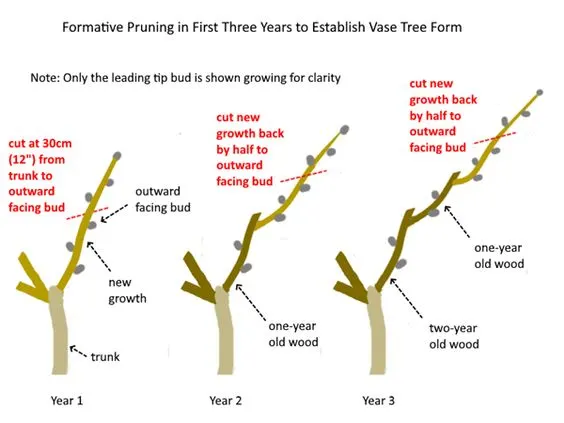
Maintain a Balanced Shape: As you prune, keep an eye on the overall shape. You’re aiming for a balanced, open canopy where sunlight can reach every nook and cranny.
Heavy pruning might seem like a big deal, but it’s all about giving your tree a fresh start and helping it flourish.
So, grab those pruners, take your time, and give your orange tree the TLC it deserves.
That’s all for today!
Let’s head toward the conclusion.
Conclusion!
So, how does it feel?
You now have the power to shape your orange trees the way you like them to be!
Pruning allows plant parents to give their plants a healthy makeover; it will enable our orange buddies to proliferate with a new look each year and motivates us to grow more of these tasty evergreen perennials in our homes and gardens.
Throughout the article, we’ve discussed when and how to prune orange trees. We’ve discovered the best ways to properly maintain a citrus tree by emphasizing the importance of using proper pruning techniques.
We hope you find this article helpful in your journey of growing healthy and happy orange trees!
Let us know in the comments how your juicy oranges turned out after the harvest.
Happy pruning!




